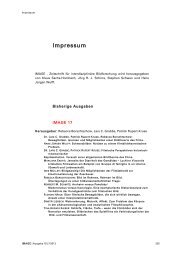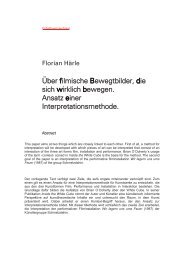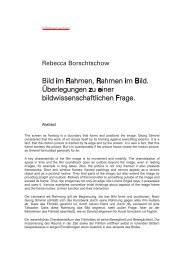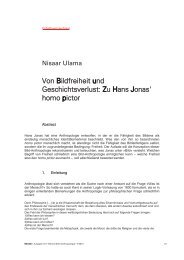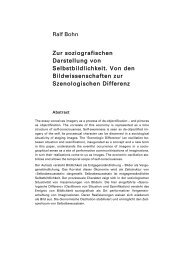Image 4 - Gesellschaft für interdisziplinäre Bildwissenschaft
Image 4 - Gesellschaft für interdisziplinäre Bildwissenschaft
Image 4 - Gesellschaft für interdisziplinäre Bildwissenschaft
Sie wollen auch ein ePaper? Erhöhen Sie die Reichweite Ihrer Titel.
YUMPU macht aus Druck-PDFs automatisch weboptimierte ePaper, die Google liebt.
MARIO BORILLO/JEAN-PIERRE GOULETTE: COMPUTING ARCHITECTURAL COMPOSITION FROM THE SEMANTICS OF „VOCABULAIRE...These relations are defined on the basis of an axiomatic system that supplements those of topologyand geometry.The topological, geometrical and meronomic relations (and their combinations within the formallanguage thus defined) make it possible to represent more complex relations between elements,these relations ›being anchored‹ in the vocabulary of architecture. One can thus formally define ›Tocrown‹ (›To form the horizontal ridge or the pyramidal top of a rise or part of rise‹), ›To be alignedwith‹, ›To be recessed‹, ›To limit‹, ›To delimit‹, ›To decrease‹, etc. One sees how much this typeof relations describes qualitatively and functionally the objects of the architectural composition.The graph below expresses the mereotopological organization characteristic for the essential elementsof the bay:3. Representing some principles of the process ofarchitectural composition3.1. The fruitful ambiguity of the linguistic description ofcompositionsThe term of ›composition‹ is ambiguous. It can indicate the process by which the components ofa more complex structure are associated and located in space. But this term, ›composition‹, canalso refer to the spatial entity that results the process of composition. In this second mean-ing(the spatial entity), the reference of this term must present a unified aspect, in the sense that itsreference constitutes one element of the architectural universe.3.2. To compose compositions: levels of interpretationUnder some conditions, some associations of bays can, in the vocabulary of architecture, be nameda bay, as well. That means that a bay can be composed of several bays. The description ofthe components of a bay reflects, in language, the diversity of the levels of interpretation that canbe associated to an architectural object. A component can then receive various deno-minationsaccording to the level of interpretation adopted.The possibility of variation in interpretation has as its consequence that the same object can beclassified, according to the adopted level of interpretation, in various terminological categories ofarchitectural entities. This leads us to define two distinct levels for the interpretation of the termsbeing used to refer to the elements of architecture: the Neutral level and the Composition level.The transition from the first level to the second one reveals the process of compo-sition, which weseek to describe.IMAGE I Ausgabe 4 I 7/2006 53



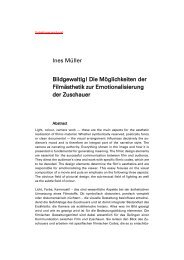
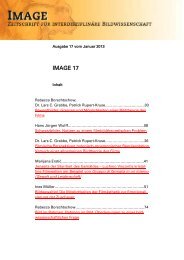
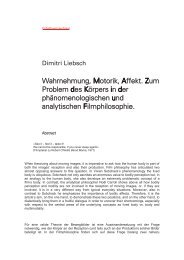
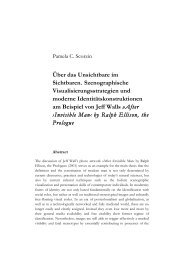
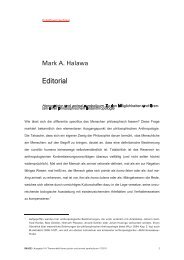
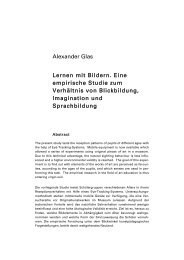
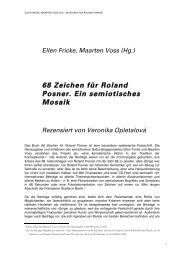
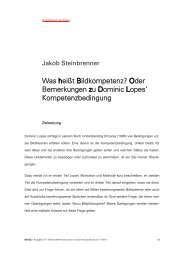
![image 11 [pdf] - Gesellschaft für interdisziplinäre Bildwissenschaft](https://img.yumpu.com/41525154/1/184x260/image-11-pdf-gesellschaft-fur-interdisziplinare-bildwissenschaft.jpg?quality=85)
